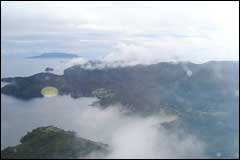|
|
|||
|
||||
|
Updated: September 12, 2001 |
|
|
|||||||||||||||||||||||||||||||||||||||||||||||||||||||||||||||||||||||||||||||
 Today tourists visit New Zealand to see these large marine mammals |
|
 Aerial view of Whangaparapara. The highlighted area shows where the whaling station once stood |
Whaling began in New Zealand waters in the 1790's. By 1839 there were over 200 ships whaling in and around New Zealand waters.
There was no shore based whaling station on Great Barrier in those early years. Boats stopped to drop their catch of at Nagle Cove (NW Great Barrier Island). These whales were cooked down to render their oil. The bones and the rest of the carcasses were ground up to make bone meal.
In the 1950's whaling became profitable again and a whaling station was built at Whangaparapara in 1957. It processed over 100 whales a year (mostly humpbacks) but had to shut down operations as whale numbers declined. It closed in 1962.